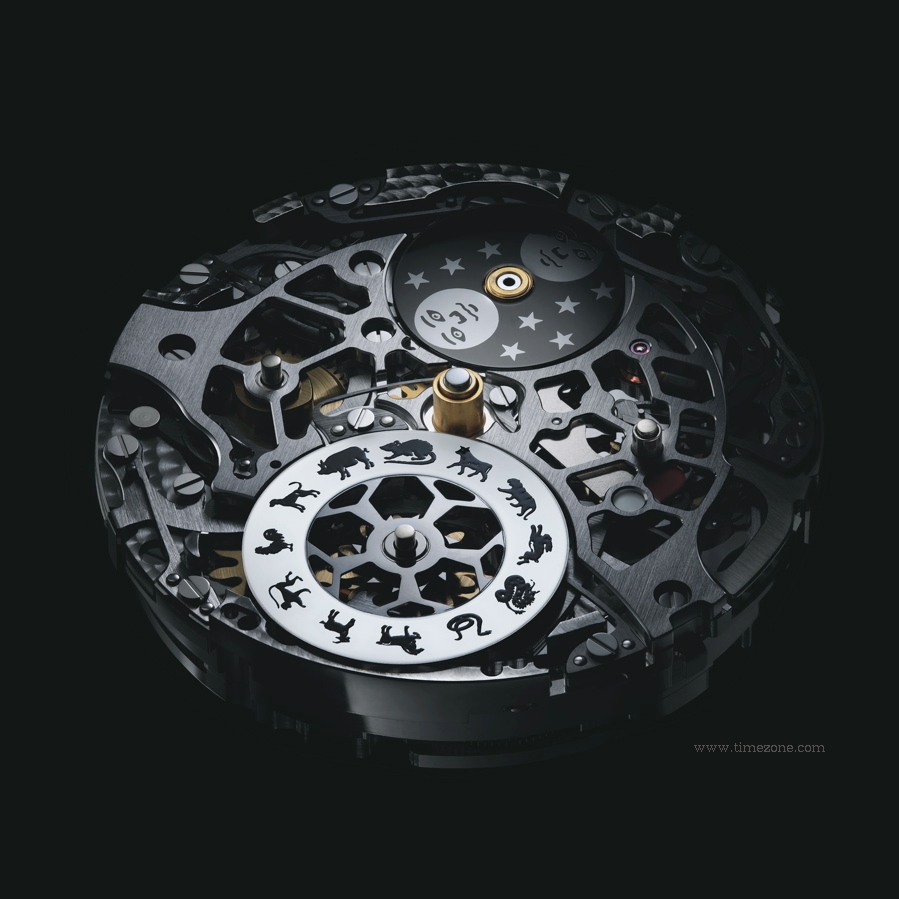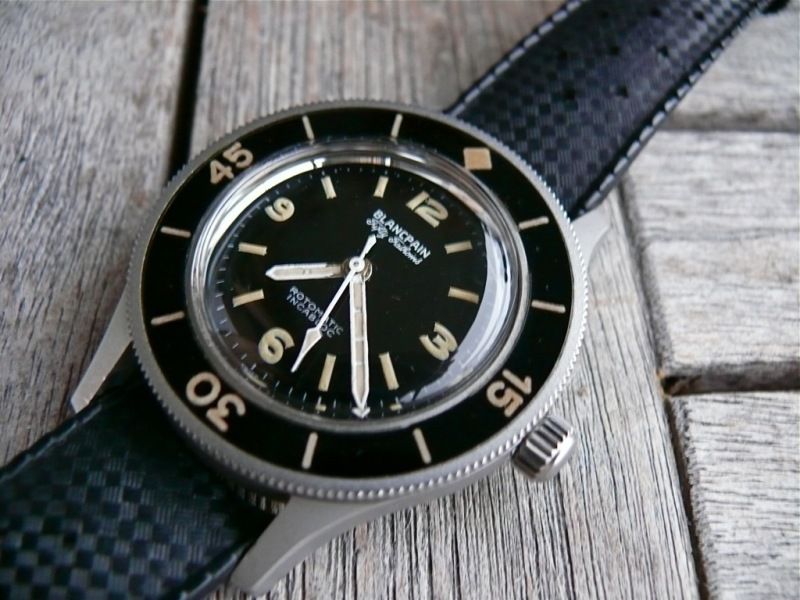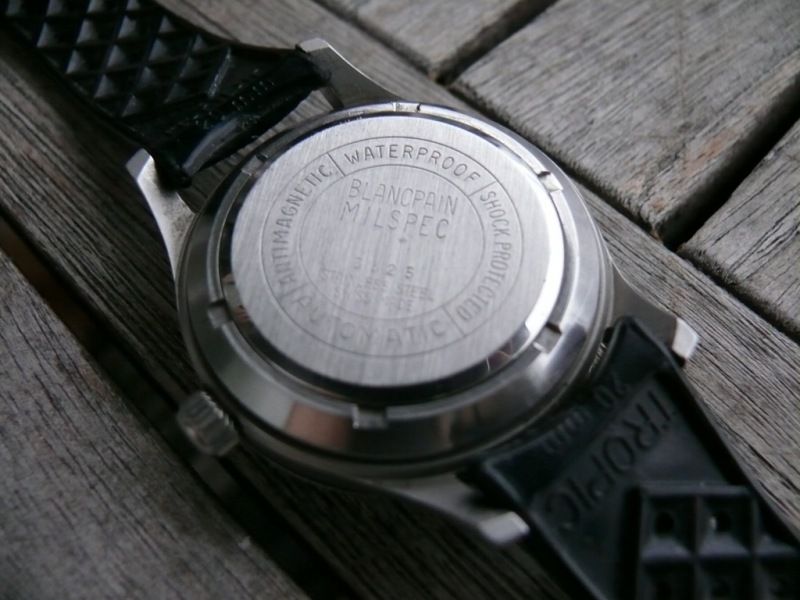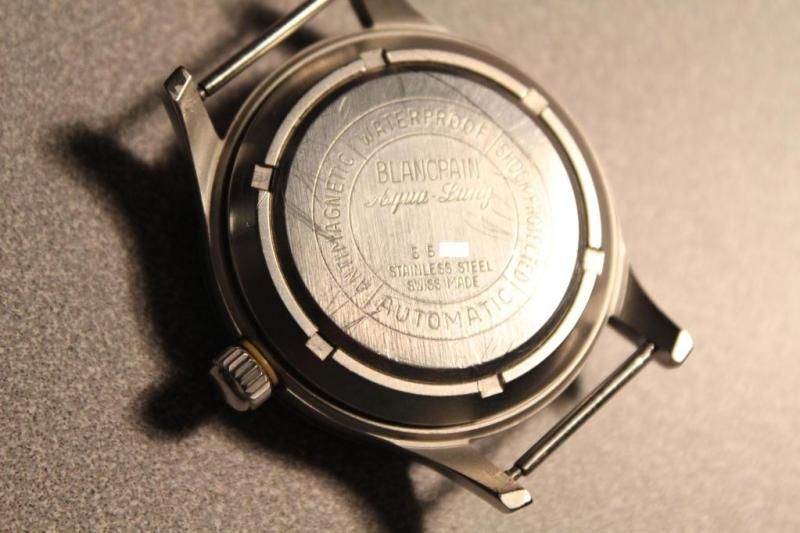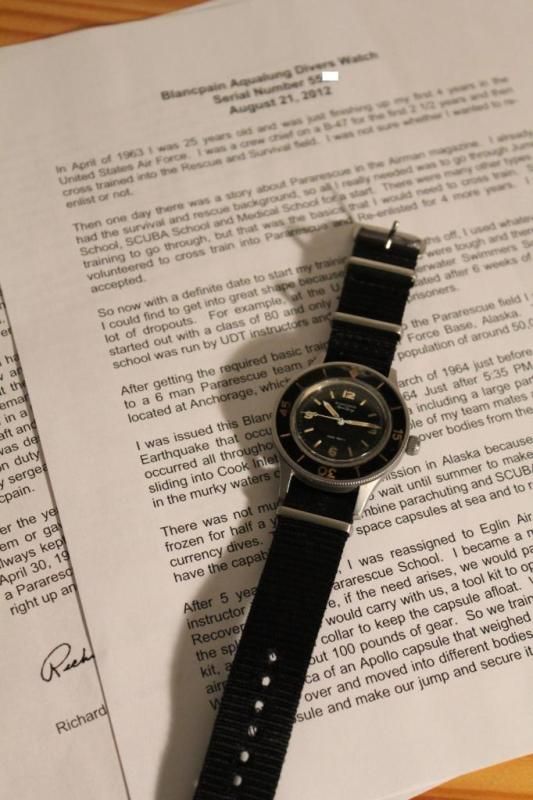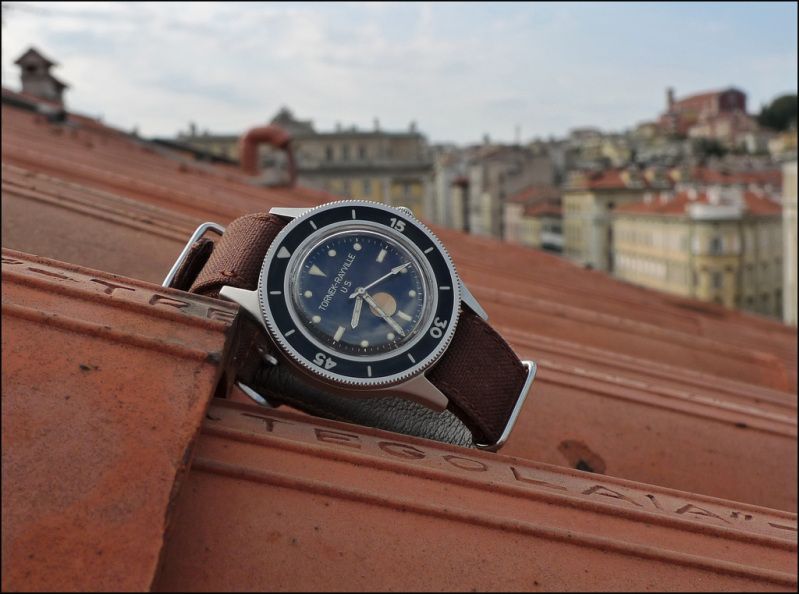BLANCPAIN - Equation of Time
The running equation of time complication is one of the rarest complications in all of watchmaking. Perhaps it is that rarity which has led others who have tried to build it down precisely the wrong path.

Blancpain is a pioneer and the industry leader in the development of the running equation of time (“equation du temps marchante”) complication in wristwatches. Doubly so. Not only was it the first to produce this complication in wristwatches, others who have endeavored to match its record have stumbled. Badly. How badly? The efforts of these others have produced watches that show the running of equation of time precisely backwards! 180 degrees wrong.
I have before me officially released photographs from the two other watch companies that have tried to implement the running equation complication. In both cases, the photos show solar time to be ahead of civil time in months when the reverse is true. Trust me on this. I checked. Brow fully furrowed, I came to the conclusive answer that these well known companies simply and clearly put down very false feet. And so that you can breathe easier and don’t need to wait until the end, I furrowed my brow one more time and verified that Blancpain’s pioneering work got it right. How could this occur? How is it that other presumably responsible and expert horologists commit an error this profound? In a word, it is because equation of time is…….confusing. Another word. It’s vexing. It’s ok to furrow your brow when you think about it. And if it will comfort you more, you can imagine it as one of those school mathematics problems. You know like the one that asks if one man can paint a house in 4 days and another man in 3 days, how long will it take if they work together? The basic concept of equation of time is not all that difficult to grasp.

Equation of time is a way of expressing the difference in the hour of a day according to what is termed “solar time” and the hour of the day according to “civil time”. Although civil time always assumes a day that is exactly 24 hours long and constant over the course of the year, solar time is calculated based upon the actual length of the day (the number of hours that pass between the time when the sun is in a given position in the sky and when it is in that same position the following day or to be a bit more precise in our terminology, the amount of time that must pass for one point on the equator to rotate 360 degrees with reference to the sun 1).
As we all intuitively know, the length of a day varies during the course of the year. This variance can be thought of as arising from defects in the orbit of the earth. That orbit is not round, but elliptical and, compounding matters, the earth’s rotation is tilted 23 degrees from the plane of the obit. As a result, the actual length of a day is not, as widely believed, 24 hours. Rather it varies approximately2 15 minutes, plus or minus from 24 hours, depending on the time of year. Thus, the exact 24 hour day which we fret and fume our watches How could this occur? How is it that other presumably responsible and expert horologists commit an error this profound? In a word, it is because equation of time is…….confusing. Another word. It’s vexing. It’s ok to furrow your brow when you think about it. And if it will comfort you more, you can imagine it as one of those school mathematics problems. You know like the one that asks if one man can paint a house in 4 days and another man in 3 days, how long will it take if they work together? .
The basic concept of equation of time is not all that difficult to grasp. Equation of time is a way of expressing the difference in the hour of a day according to what is termed “solar time” and the hour of the day according to “civil time”. Although civil time always assumes a day that is exactly 24 hours long and constant over the course of the year, solar time is calculated based upon the actual length of the day (the number of hours that pass between the time when the sun is in a given position in the sky and when it is in that same position the following day or to be a bit more precise in our terminology, the amount of time that must pass for one point on must measure ever so precisely is not exactly 24 hours at all except for four days per year: April 15 (the day that inspires frissons for the American readers as that is tax day), June 14, September 1 and December 24. This exact 24 hour day that most watches measure is known as “Mean Solar Time” or more commonly “civil time”, since it represents a convenient compromise of the variation. The difference between solar time and civil time is the Equation of Time. It is common that this is charted in a graph known as an “Analemne”.
1 As long as we are being precise here, one must specify the particular reference point which is being used when determining the amount of time that passes during 360 degrees of rotation of the earth. Real Solar time uses the sun as the reference point. Sideral time uses a fixed point in space (a distant star or distant galaxy, your choice, suffices). A Sideral day is 8.5 minutes shorter than a Solar day. Hence there are 366 Sideral days per year.
2 All right! Since we are talking physical effects here no sense in dealing with approximations—the actual variation is minus 16 minutes 23 seconds and plus fourteen minutes 22 seconds. Better now?

Regrettably the anglophones seem to have let down on the job and have not created their own word for the chart that shows how the Equation of Time varies over the course of a year.
It can be quickly seen that the greatest positive variance occurs in February and the greatest negative variance in November. The four days where civil time and solar time are the same show on the zero axis.
What is confusing — so much so that these watchmakers elsewhere stumbled — is the relationship between solar time and civil time on any given day. Take for example the 12th of February. On that day the solar day is 14 minutes longer than the civil day. So far so good. But then, if one wants to produce a watch that will show both solar time and civil time, how will that be displayed? In simple terms, “if it is noon civil time, what is the solar time?” By furrowing my brow a lot I came up with a simple minded way of answering the question. Since the solar day is longer than the civil day, it stands to reason that solar time would be 14 minutes behind civil time. That is all very logical. What happens if you want to reduce the relationship to an equation, the “equation for the equation”?

Train wreck! Equation of time is expressed in two opposite ways. Although it is clear, for any given calendar date, whether the solar day is longer or shorter than the civil day, and equally clear whether solar time is advanced or retarded in relation to civil time, the value of equation of time depends upon whether one is measuring civil time in relation to solar time or the reverse.
If one is measuring civil in relation to solar time the formula is: Equation of time = Solar time minus Civil time on the other hand if one is measuring solar time in relation to civil time the formula is: Equation of time = Civil time minus Solar time. Here is the rub. Depending upon which frame of reference one is following, for a given day the equation of time will have exactly the opposite value. Staying with our February 12 example, under the first formula, equation of time will be minus 14; under the second formula it will be plus 14. However in both instances the solar day will be longer than the civil day and solar time will be 14 minutes behind civil time. Confused yet?
Equation of time has been one of the rarest wristwatch complications. Since it is expressing a value that changes over the course of the year, it has with the fewest of exceptions only appeared in time pieces offering perpetual calendars. This is a natural pairing as it brings together two complications that take account of yearly variances—equation of time, tracking the changes in the length of the solar day, and the perpetual calendar, keeping track of the varying length of months. As watch connoisseurs know both of these are examples of traditional watchmaking’s grand complications. So it is right to think of equation of time as being a grand complication on top of another grand complication.
Until 2004, all wristwatch equation of time models offered only a plus/minus expression of the equation of time. That is they offered values such as “plus 14” or “minus 10” without indicating whether the conversion was from civil time to solar time or the reverse. It was left up to the owner of the watch to sort out that vital detail.

Everything changed when Blancpain introduced its Le Brassus Equation du Temps Marchante at the 2004 Basel fair. For the first time in watchmaking history, a wristwatch was offered that not only displayed a plus/minus expression of equation of time, but a running (or in French “marchante”) equation of time minute hand which directly showed solar time. No longer was it a mystery, left to the owner to decipher, whether the equation reading was converting from civil to solar or instead solar to civil. Instead, Blancpain’s pioneering Equation du Temps Marchante showed two minute hands, one for civil and one for solar (the solar hand bearing a sun) so that the owner could directly read both times.
Take for example the date of September 22 shown on the perpetual calendar display in the photo of the red gold version of the Villeret Equation du Temps Marchante. On this date, the running equation of time solar hand shows that solar time is approximately 8 minutes ahead of civil time and the equation scale at 2 o’clock shows + 8 minutes.
Now that we have established that the Blancpain’s running equation of time complication can be simply read—brows unfurrowed, lucky owner relaxed—let’s turn to how the marchante mechanism works. At first this does not seem to be all that tricky. Simply incorporate into the movement of the watch an ellipsoidal cam in the shape of the anelemne which turns once a year. As that anelemne turns, a finger (or ratchet) riding upon it will move (or be programmed) according to the changes in the length of solar days which the anelemneshaped ellipsoidal cam expresses. This is the classic way in which conventional less complicated equation of time displays have been constructed for over 200 years. The trick is devising a method to have the solar hand both move as a conventional minute hand and an equation of time hand. Well just how do you do that???? How do you construct a solar minute hand mechanism that, in part, must be driven in the same way as the civil minute hand (that is to say by the minute hand gear train) and, in part, driven by a cam so as to add or subtract time from it? There must be two different sources of rotation for the marchante solar hand and neither can interfere with the other (if that were to happen the watch would stop).
Some of the components reveal themselves. The ellipsoidal cam can be easily identified as can the finger which rides on it. The lever attached to the finger drives two separate mechanisms: one for the indication at 2 o'clock, which shows the +/- indication and the other the machante hand.
The secret is the gear in the marchante train labeled “Differential”. That is not one single gear, but an entire differential mechanism which contains small satellite gears within it. It is the component which is driven from two different sources one drives a gear which drives the satellites (the marchant train) and the other which drives the main exterior gear component (the watch’s minute train). The satellite gears can move freely forward and backwards without disturbing the movement of the minute hand and the minute hand train.

This movement which achieved a watchmaking first in 2004 (in the Le Brassus series which was a limited edition that sold out immediately) has now been reborn in the new Villeret Collection. As was the case with its 2004 Le Brassus predecessor, the new Villeret Equation du Temps Marchante, places itself on the highest levels of watchmaking complication as it offers a full perpetual calendar, retrograde moon phase display, and two equation of time indications (one on a +/- scale and the other with a running solar hand). As befits a timepiece of this degree of complication, Blancpain will offer the new Villeret only in precious metals, platinum (limited to 50 pieces) and red gold. In both cases the diameter of the case is 42 mm.
To further mark the exclusivity of this piece, the dial is fashioned in full fired bombé enamel. One element of the dial’s design is unique, the porthole at six o’clock. It offers a view of the equation of time cam and the ratchet which rides upon it. Of course this can be thought of as opening up for viewing some of the complicated elements of the movement. But there is much more. The equation of time cam is an expression of the physical universe. Its precisely calculated shape embodies the relationship of the earth’s orbit and rotational inclination to the sun. So go ahead, think of this as a porthole to our part of the solar system.
Since the debut of the first equation of time watch, Blancpain has introduced its patented correctors under the lugs. Whereas others in the industry offering complicated calendar/moon phase displays are obliged to fit correctors into small dimples on the sides of the case for the setting of the indications, Blancpain’s patented correctors are located where they are not a visible intrusion, under the case lugs. This allows the watch to have not only a completely clean side profile, unmarred by dimples, but for the owner to actuate the correctors with a finger tip instead of a tool which ordinary correctors require. The new Villeret Equation du Temps Marchante now incorporates this Blancpain exclusive innovation.
Hand engraving is one of the rarest crafts in all of watchmaking. Whereas the common practice in the industry is to “farm out” engraving to a few independent artisans, Blancpain is one of less than a handful of watch brands that has been able to maintain and nourish this skill within its four walls. That Blancpain in-house savoir faire is on display in the new Villeret Equation du Temps Marchante. The visible movement bridges are all painstakingly hand carved into one of two designs: Universalis, which is a portrayal of the constellations, and Cartographia, a depiction of navigational charts, each further highlighted by hand carved winding rotors maintaining the theme of the bridges. To produce these carvings, the artisans in Blancpain’s workshops labor at their benches with the component under a microscope. Operating in these micro dimensions, there is neither a time clock nor a deadline. Carving in metal allows for no errors. Every gesture with knife or awl must be precise and perfect. If a painter makes a mistake, it can be painted over. If an engraver makes a mistake, the part must be thrown away and the labor restarted on another new component. The Universalis design is reserved for the models in red gold, while the Cartographia design will be featured in the platinum models.
A final finishing touch is the winding rotor, visible through the clear caseback. Realized in gold, the rotor is hand decorated with a solar pattern which includes special windows to frame the word “Blancpain” hand engraved on the bridge below.
http://www.worldtempus.com/en/news/top- ... n-of-time/












